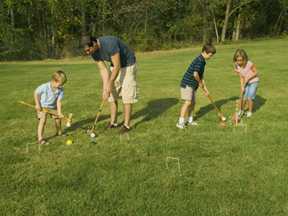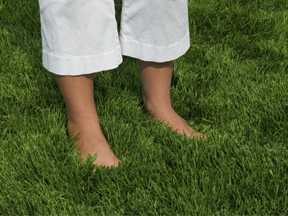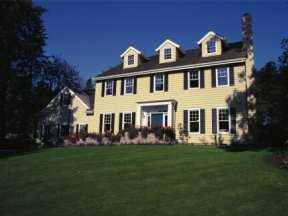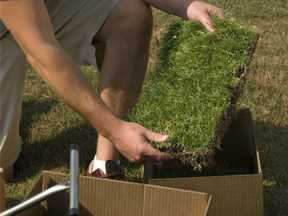Why Zoysia?
- The key reasons zoysia is so attractive for homeowners
- Soil Conditions
- Slopes and Borders
- Safety
- Winter Dormancy
- What About Zoysia Seed?
- What do Zoysia Plugs look like?
- How are plugs shipped?
- How long will the plugs last before planting?

This is why it is so dense and effective at choking out most summer weeds and replacing existing grass. With our superior blend of zoysia, Amazoy®, you can plant a network of plugs in a new or existing lawn and it will grow into a lush, even, weed-free lawn within several growing seasons.
The key reasons zoysia is so attractive for homeowners:
Cuts water bills
- Zoysia's vigorous root system is so deep and extensive the grass rarely, if ever, needs watering -- zoysia can really cut your water bills.
Reduces mowing by two-thirds
- The lateral growth of zoysia means it grows tall very slowly -- most people mow zoysia once for every three times they need to mow other grasses!
Zoysia thrives in heat and cold

- "The hotter it gets, the better it grows." Zoysia loves blistering heat and yet it won't winter kill either -- it can survive to 30° below zero. It's perfect for extreme conditions as well as mild climates.
- Amazoy plugs will thrive in the heat and sunshine, but will not be damaged by snow or cold weather conditions. Amazoy can withstand temperatures of 120° to -30°Fahrenheit.
Chokes out crabgrass and weeds all summer long
- Your established zoysia lawn grows so thick with deep roots that crabgrass and other summer weed seeds cannot germinate.
No more chemicals
- Since zoysia naturally resists insects and diseases, you avoid the cost, time and risk of exposing your family and pets to weedkillers and pesticides.
Never needs replacement -- even heals itself
- It's beautiful and tough. The way it naturally grows outward along the ground in all directions, zoysia grass acts like a network of plants that can withstand heavy use, and will fill in if damaged.
Zoysia is THE answer for slopes, play areas and bare spots
- You can't beat zoysia for hard to cover spots, worn areas or to end erosion on slopes. It even levels out ground irregularities.
You don't pamper zoysia - You enjoy it!
Soil Conditions
Clay Soil

Rock-like Soil
Amazoy zoysia plugs will grow in rock-like or granite soil, but you will need to mix in a layer of top soil before planting.Salty soil
Amazoy zoysia plugs will grow in most salty soils. Because zoysia grass is highly salt tolerant, it is recommended for areas near coastlines where salty soils are often found. Amazoy will grow well in areas near roads and driveways that are salted to melt winter ice and snow.Sandy soil
Amazoy zoysia plugs grow especially well in sandy soil because there are many airspaces that allow zoysia's roots to penetrate, providing quicker root development.Soil pH
Although Amazoy zoysia grass grows well in many different types of soil, the ideal soil pH level is 6 to 7. pH levels can be altered by using granulated lime to raise the pH level or small quantities of sulfur to lower it. When using sulfur, it is important not to over-apply, as sulfur is an acidifying agent that can burn lawns. Insert a pH meter into your soil at several locations to determine pH levels. We offer an easy to use pH Meter.Full Sun
Amazoy will thrive in full sunshine and is heat tolerant to temperatures up to 120°FShady Conditions
Amazoy can be planted in part shade, as long as the area to be planted gets at least 2 to 3 hours of direct sunlight a day.If you are planting your plugs under trees, make sure that the pH of the soil is between 6 and 7. Trees have a tendency to alter the pH of your soil. pH levels can be modified by using granulated lime to raise pH and small quantities of sulfur to reduce it.
To determine the pH of your soil, use a pH meter or soil testing kit. We offer an easy to use pH Meter and Soil Test Kit.
Slopes and Borders
Excellent on Slopes and Hills
Amazoy zoysia works very well in areas with steep slopes and hills. Amazoy plugs make it easy to plant the grass on steep areas and once established they will create a thick carpet-like grass. It will also require less mowing, which can be difficult and dangerous on steep slopes.Great Erosion Control
Amazoy's deep root system (about 2 feet when fully established) and the thickness of the turf will work to significantly reduce slope erosion. Amazoy plugs make it easy to initially plant zoysia on steep areas as well.
Children and Pets
Safe for Children and Pets
Amazoy zoysia is completely safe for children and pets. Because there is no need to use poisonous chemicals on your lawn, your children and pets can romp on the lawn without fear of contamination. Zoysia's durability means you will have no worries about damage that can result from lawn play.More Tolerant of Animal Waste
Zoysia is more tolerant to pet urine and feces than most grasses. However, no grass will survive prolonged or constant exposure to pet waste. Pets should be kept off of the new plugs for at least 30 days in order for the plugs to become established.After the plugs are established, you can minimize the effects of pet waste by periodically liming the soil in order to restore the pH level to an acceptable range between 6 and 7.
Safe for Horses and Dogs
Amazoy grass plugs are safe for horses and dogs. While zoysia has minimal nutritional value, eating zoysia will not harm horses and dogs.
Safe for Wells and Septic Systems
Amazoy zoysia grass is safe for wells and septic systems as well as leach fields. The developed root system of zoysia may reach 2 or more feet below the soil surface but cannot penetrate well walls, septic systems or damage underground lines.Resists Pests
Amazoy has an inherent resistance to the effects of most insects and diseases and resists injury from most chemicals when pest populations do require controls.Chokes Out Weeds
Once established, the dense turf created by zoysia significantly reduces summer weeds. Amazoy will choke out all existing cultivated and wild grasses, including Bermuda (often called wire grass) and St. Augustine. For best results keep these grasses away from newly planted zoysia plugs.Winter Dormancy
Zoysia, like deciduous trees, goes dormant after the first killing frost and will go off its green color until the ground reaches temperatures of about 50°F in the spring. This is a normal, healthy process. In fact, zoysia's ability to go "dormant" is important to its ability to better withstand extreme winter cold and still come back full and green every spring. Amazoy will not be damaged by snow and cold weather conditions. Amazoy can withstand temperatures of -30°Fahrenheit ( -30°F below zero).What About Zoysia Seed?

Historically, it has been extremely difficult to create a fine Zoysia grass lawn from seed. However, Zoysia seed has come a long way over the last few decades. It now germinates better producing a beautiful lawn, but still has some very particular requirements in order to be successful. Our experience is that it is possible to establish a lawn from the Zoysia seed and we now are making available Zoysia seed to homeowners. We only supply what we believe to be the best of the best and the one that meets our standard for quality and durability.
There are very specific requirements for how deep to plant the seed, the amount of light it needs, and watering. It will be important to follow the seed planting instructions carefully for success.
Click to order Amazoy Zoysia seed now!

What do Zoysia Plugs look like?
Amazoy Zoysia grass resembles Kentucky bluegrass as far as texture and appearance. Each plug is a small piece of Zoysia sod that can measure as small as 1 inch square but can be much bigger in size just never smaller.How are plugs shipped?
Amazoy Freestyle Plugs are shipped in 10" by 15" sheets of grass. Each sheet can produce up to 150 — 1" square plugs. The plugs can be cut bigger, that's the freestyle part. Bigger plugs means less cutting and less planting, but you will get less plugs from each sheet.Super Plugs are precut for you into individual 3" by 3" plugs that are ready to plant. They will arrive in easy-to-handle trays of 15 Super plugs.
All plugs are shipped the same day they are packed with a moisture-proof lining so the roots reach you fresh, vigorous and ready to grow.





